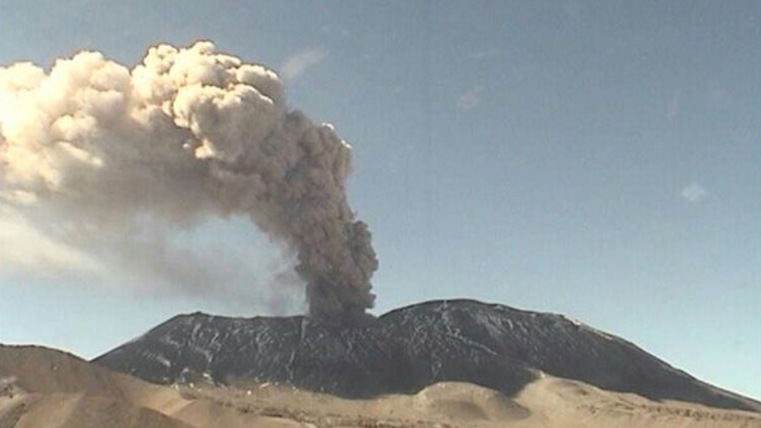Moderately strong ash eruption of Lascar volcano, Chile

Chile's Lascar volcano experienced a moderately strong ash eruption around 12:30 UTC on October 30, 2015. Sernageomin reported volcanic ash column of 2.5 km (8 200 feet), drifting NE. The alert status was raised to Yellow.
It is unclear whether the eruption was caused by fresh magma or, more likely, by an explosion of overheated water (phreatic activity), Volcano Discovery said.
There had not been any particular indication of new activity. According to Sernageomin's routine reports, seismic activity under the volcano, dominated by earthquakes related to internal fluid movements, had been progressively decreasing during the past months, from a total of 207 in May to 62 events in September.
This was Lascar's first eruption since April 2013. According to GVP, Sernageomin reported that during March [2013] a web camera monitoring Láscar recorded white gas plumes rising 600 m above the crater. At night during April 2 – 4 incandescence from the crater was observed. On April 3 increased emissions from the crater fluctuated from white to gray, indicating possible ash. Plumes rose 320 m and drifted SE. Seismicity remained at normal levels during the increased emissions. On April 5 the Alert Level was raised to Yellow.
Geologic summary
Láscar is the most active volcano of the northern Chilean Andes. The andesitic-to-dacitic stratovolcano contains six overlapping summit craters. Prominent lava flows descend its NW flanks. An older, higher stratovolcano 5 km E, Volcán Aguas Calientes, displays a well-developed summit crater and a probable Holocene lava flow near its summit (de Silva and Francis, 1991). Láscar consists of two major edifices; activity began at the eastern volcano and then shifted to the western cone.
The largest eruption took place about 26,500 years ago, and following the eruption of the Tumbres scoria flow about 9000 years ago, activity shifted back to the eastern edifice, where three overlapping craters were formed. Frequent small-to-moderate explosive eruptions have been recorded since the mid-19th century, along with periodic larger eruptions that produced ashfall hundreds of kilometers away. The largest historical eruption took place in 1993, producing pyroclastic flows to 8.5 km NW of the summit and ashfall in Buenos Aires. (GVP)
Featured image credit: Lascar volcano eruption on October 30, 2015.

Commenting rules and guidelines
We value the thoughts and opinions of our readers and welcome healthy discussions on our website. In order to maintain a respectful and positive community, we ask that all commenters follow these rules:
We reserve the right to remove any comments that violate these rules. By commenting on our website, you agree to abide by these guidelines. Thank you for helping to create a positive and welcoming environment for all.